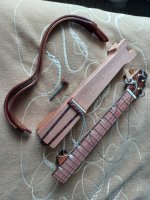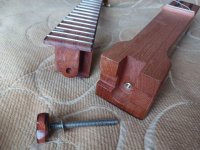RideInSunshine
Member
Design goals:
I wanted to make a compactly portable baritone ukulele with full playing comfort that I could play quietly in hotel rooms or late at night, or not far from where camping companions slept, or in airports or in other populated places. Because, though I hate to admit it, my beautiful flailings upon my instrument are not universally welcomed at all places at all times.
I allowed myself to be inspired by a certain well known guitar by a major company, but would have to find my own path forward. Fully assembled, it should be comfortable and familiar. For ease of travel, it should disassemble into smaller components. A removable pair of nesting skeletal bouts would trim its packable width. And, for those travels requiring ultimate compactness, the strings could be loosened and the body and neck separated. I wanted a standard, familiar headstock, but allowed that it should be minimized. And chose to add an undersaddle pickup, for use with a recording device and headphones, or to serve in the event that I be suddenly asked to grace a stage. (This happens all the time in my imagination, but in actuality is such a rare event that it has never happened.)
I dove in, unsure exactly where and how or if it would all come together as hoped. I present this list of materials:
Body and neck - Spanish cedar
Bouts - sapele
Fingerboard and bridge - machiche
Fingerboard binding - pheasantwood
Fret markers - tagua nut
Structural reinforcement - straight grain walnut
Decorative highlights - figured walnut from a friend who harvested it on family property some years ago.
Frets - medium nickel silver
Neck bolt - 1/4" w/walnut and machiche knob
End latch - walnut/machiche
End pin - brass
Tuners - Grover Sta-Tite
Strings - Aquila Lava
Pickup - Fishman undersaddle








I wanted to make a compactly portable baritone ukulele with full playing comfort that I could play quietly in hotel rooms or late at night, or not far from where camping companions slept, or in airports or in other populated places. Because, though I hate to admit it, my beautiful flailings upon my instrument are not universally welcomed at all places at all times.
I allowed myself to be inspired by a certain well known guitar by a major company, but would have to find my own path forward. Fully assembled, it should be comfortable and familiar. For ease of travel, it should disassemble into smaller components. A removable pair of nesting skeletal bouts would trim its packable width. And, for those travels requiring ultimate compactness, the strings could be loosened and the body and neck separated. I wanted a standard, familiar headstock, but allowed that it should be minimized. And chose to add an undersaddle pickup, for use with a recording device and headphones, or to serve in the event that I be suddenly asked to grace a stage. (This happens all the time in my imagination, but in actuality is such a rare event that it has never happened.)
I dove in, unsure exactly where and how or if it would all come together as hoped. I present this list of materials:
Body and neck - Spanish cedar
Bouts - sapele
Fingerboard and bridge - machiche
Fingerboard binding - pheasantwood
Fret markers - tagua nut
Structural reinforcement - straight grain walnut
Decorative highlights - figured walnut from a friend who harvested it on family property some years ago.
Frets - medium nickel silver
Neck bolt - 1/4" w/walnut and machiche knob
End latch - walnut/machiche
End pin - brass
Tuners - Grover Sta-Tite
Strings - Aquila Lava
Pickup - Fishman undersaddle

















